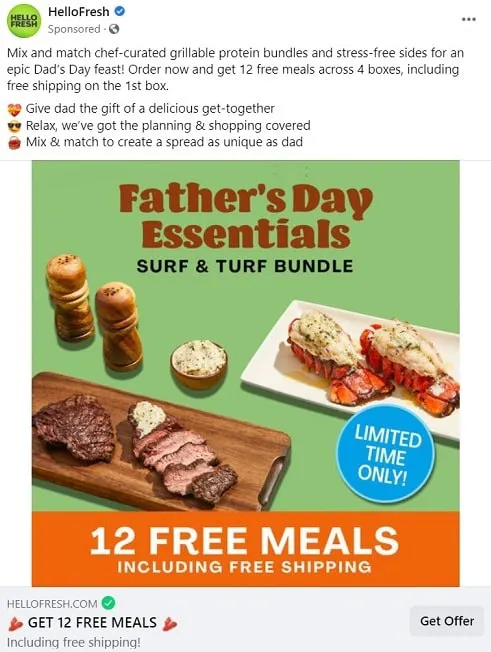Advertising has always been at the front and center of everything we do, whether it’s checking the mail, watching TV, or reading the newspaper. In the digital age, advertising has transitioned heavily into electronic territory, like email ads, Google search ads, and Facebook ads. Whatever the type of advertising, its goal is ultimately to build a larger customer base.
But while some ads are more for nurturing customer relationships, others are made for a quick return-on-investment (ROI), as is the case with direct response marketing. This form of advertising is popular on social media and websites, which can easily grab someone’s attention for a quick click and conversion.
What Is Direct Response Marketing?
Screenshot via NerdFitness.com
Unlike forms of advertising that focus on building brand awareness, direct response marketing looks for immediate action in response to advertising. In other words, a direct response. Direct response marketing can take on many forms, like a social media ad, a radio ad, or a text ad, but they all have the same goal, which is to get people to sign up or buy right away.
It’s important to note that direct response marketing isn’t always about money. For example, a popup offer on a website that promises a free PDF download in exchange for an email address is a form of direct response marketing. The marketer gets another email address for an email list, and they can use that email address to immediately build a relationship with and market to the customer. NerdFitness.com, for example, calls out its free tools, downloadable guides, and other valuable resources to entice visitors to sign up for a newsletter, offering an exclusive startup kit to those who sign up.
Direct response marketing must include two very important pieces: an offer of some kind and a call-to-action (CTA). The offer should be appealing to a specific audience, and the CTA should be quick, snappy, and clear. A direct response ad usually also includes just enough information to entice someone to take action.
Because direct response marketing is targeted toward conversions, making successful direct marketing ads is a skill that can take time to perfect. They require a different approach than advertising that’s used to get people to warm up to a brand before taking any kind of action.
How to Ace Direct Response Marketing
How can you make sure your direct response marketing tactics get the action you’re looking for? Stick with these tips and best practices:
Use Precise Targeting
Targeting brings your ideal audience right in front of your offer and advertisement. Just about any ad network allows you to target the ads you place, but you can also use targeting methods if you’re placing offers in emails or on your site.
How? You can create multiple email lists if your services or products can appeal to different groups of people. You might have one list for business customers of your SaaS product and another for personal-use customers, for example. For your site, you can make different offers that relate to your blog posts to appeal to people reading that post.
Display a Sense of Urgency
Screenshot via HelloFresh on Facebook
Making your audience feel a sense of urgency that they should act on your offer now can boost its conversions. You’ll often notice some sense of urgency in direct response marketing to make an ad get results immediately, as direct response ads are meant to do. HelloFresh uses this tactic in its Facebook ads, noting that customers can get 12 free meals when they sign up, including a tasty Father’s Day surf and turf bundle that’s available for a limited time only.
One way advertisers manage this is with a countdown timer, which you’ll often see when you browse hotels or flights to book. But you can also achieve a sense of urgency with a quick pop-up that highlights a better offer when someone takes action within the next few minutes, or by noting that there’s limited availability of an item.
Offer Something Irresistible
The better your offer, the more likely it is that your audience will sign up or buy. Offering something for free can be an excellent way to get people to click, sign up, or grab a trial that turns them into full-time customers. Whatever your offer, make it visible and clear in your marketing.
Make Your CTA Crystal Clear
A CTA only needs to be a few words long, at most, to get people to understand it and take action. A short, simple CTA that tells people exactly what to do is the best way to turn lurkers into active customers. Here are a few examples of CTAs that can be successful when paired with the right offer:
- Learn more
- Sign up today
- Download the free guide
- Try for free
- Get your free copy
- Grab a free trial
- Start the course
- Get started free
Get Creative with Your Marketing
There’s more to direct response marketing offers than free trials and discounts. To get immediate action, consider branching out into creative offers, like upselling or referral programs. You can also use chatbots to send offers to customers through social media or your website, hold a contest or giveaway, or include something free with a minimum purchase. The sky’s the limit when it comes to juicy offers.
Need help with your direct response marketing efforts? Try the POWR Popup Builder to create engaging popups to generate leads and boost sales in minutes. ShareThis has partnered with POWR to make it available to publishers directly from our platform, so it’s incredibly easy to implement. Plus, with plenty of easy-to-use templates to choose from, you don’t need to be a design expert to create powerful popups.






